Was ist Fansipan & wo liegt es?
Fansipan, der mit einer beeindruckenden Höhe von 3.147,3 Metern emporragt, wird als der höchste Berg der Indochinesischen Halbinsel anerkannt, die Vietnam, Laos und Kambodscha umfasst. Diese Auszeichnung hat ihm den Spitznamen „das Dach von Indochina“ eingebracht. Er liegt in der Provinz Lào Cai im Nordwesten Vietnams, etwa neun Kilometer südwestlich von Sapa, eingebettet in die Hoang Lien Son Gebirgskette. Der Berg ist ein bedeutender Teil des Hoàng Liên Nationalparks. Administrativ liegt Fansipan an der Grenze zwischen dem Tam Đuong District in Lai Chau und der Stadt Sapa in Lao Cai.
Option 1: Fansipan Besteigen
Fansipan, der höchste Berg Vietnams, war lange Zeit ein Anziehungspunkt für Kletterer. Früher war das Besteigen die einzige Möglichkeit, den Gipfel zu erreichen, und die Reise konnte bis zu 5-6 Tage dauern. Mit der Einführung eines Seilbahnsystems ist die Zahl der Kletterer deutlich zurückgegangen, doch die Option zu klettern bleibt für diejenigen, die das traditionelle Erlebnis suchen.
Deine Route zum Gipfel Wählen
Der Aufstieg zum Fansipan ist sowohl steil als auch anspruchsvoll. Während er früher mehrere Tage dauerte, hat sich die Zeit durch Verbesserungen erheblich verkürzt. Der Aufstieg kann derzeit in etwa drei Tagen abgeschlossen werden, oder sogar in zwei Tagen für diejenigen mit guter Fitness. Für erfahrene Kletterer ist auch ein anspruchsvoller eintägiger Aufstieg machbar.
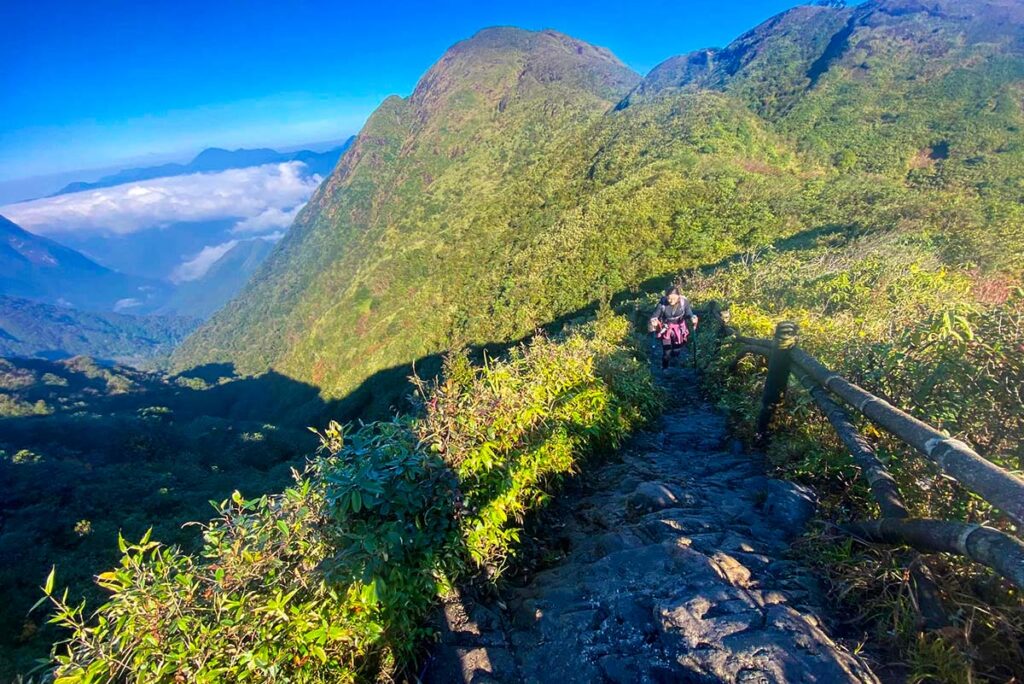
Geführte Touren und Unterkünfte
Das Besteigen des Fansipan erfordert die Begleitung eines Führers, da Solo-Expeditionen nicht erlaubt sind. Verschiedene Reiseveranstalter bieten geführte Erlebnisse an. Ein zwei- oder dreitägiger Aufstieg wird für die meisten empfohlen, da ein eintägiger Aufstieg extrem herausfordernd und nur für Experten geeignet ist. Für mehrtägige Aufstiege stehen Unterkünfte zur Verfügung. Es gibt ein Dorf auf 1.500 Metern und ein höher gelegenes Camp auf 2.800 Metern für Übernachtungen, die normalerweise in deinem Tourpaket enthalten sind.
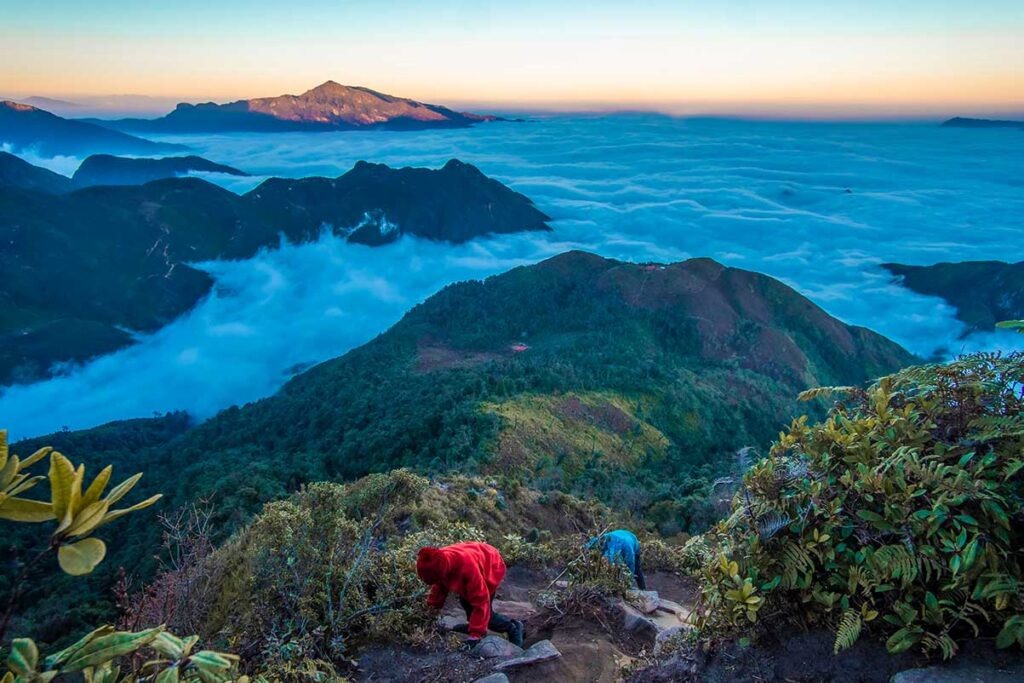
Den Gipfel Erreichen
Bei zwei- oder dreitägigen Touren erreichen die Kletterer den Gipfel normalerweise am Morgen. Dieser Zeitpunkt ermöglicht oft einen atemberaubenden Blick auf die Wolken, die die Täler darunter füllen. Nach dem Genießen des Gipfelerlebnisses haben die Kletterer die Wahl, wieder hinunter zu wandern oder die Seilbahn nach Sapa zu nehmen, was eine einzigartige Perspektive auf die Landschaft und einen entspannteren Abschluss des Abenteuers bietet.
Option 2: Fansipan Seilbahn
Für diejenigen, die nicht wandern möchten oder deren Budget oder körperliche Verfassung dies nicht zulässt, bietet die Fansipan Seilbahn eine zugängliche Alternative, um den Gipfel zu erreichen. Seit Februar 2016 bietet dieses Seilbahnsystem eine bequeme und malerische Route zum Gipfel des Fansipan.
Seilbahn: Eine Rekordverdächtige Reise
Die Fansipan Legend Seilbahn erstreckt sich über 6.292,5 Meter und ist die längste Drei-Seil-Umlaufbahn der Welt. Darüber hinaus hält sie den Rekord für den größten Höhenunterschied, den eine Drei-Seil-Umlaufbahn überwindet, nämlich 1.410 Meter.

Während du durch die Wolken gleitest, genießt du spektakuläre Ausblicke über das Muong Hoa Tal und die Gipfel der Hoang Lien Son Range. Diese Ingenieursleistung ist im Guinness-Buch der Rekorde anerkannt. Die Fahrt zum Gipfel mit der Seilbahn dauert etwa 15-20 Minuten und bietet eine einzigartige und atemberaubende Perspektive auf die natürliche Schönheit der Region.
Ticketpreise & Öffnungszeiten
- Öffnungszeiten:
- Täglich von 7:30 Uhr bis 17:30 Uhr.
- Beste Zeit für einen Besuch:
- Gegen Mittag für klareres Wetter und weniger Nebel.
- Ticketpreise:
- Erwachsene: VND 700,000.
- Kinder: VND 400,000.
- Frei für Kinder unter 1 Meter Höhe.
- Zusätzliche Hinweise:
- Sonnenaufgangs- oder Sonnenuntergangsbesichtigungen sind aufgrund der Öffnungszeiten nicht möglich.
- Tickets sind an der Station und online erhältlich.
- Die Seilbahnfahrt bietet ein einzigartiges und unvergessliches Erlebnis.
Wie komme ich von Sapa nach Fansipan?
Die Seilbahnstation für Fansipan befindet sich im Sun World Fansipan Legend Touristengebiet, etwa 3 Kilometer vom Stadtzentrum von Sapa entfernt. Besucher haben mehrere Möglichkeiten, die Seilbahnstation zu erreichen:
Mit dem Taxi
Ein Taxi zu nehmen, ist der schnellste und bequemste Weg, um die Fansipan Seilbahnstation von Sapa aus zu erreichen. Die Fahrt dauert in der Regel etwa 10 Minuten und kostet ungefähr VND 40.000. Diese Option ist ideal für diejenigen, die einen schnellen und einfachen Transfer suchen.
Zu Fuß
Für diejenigen, die lieber zu Fuß erkunden möchten, ist die Seilbahnstation vom Stadtzentrum Sapas aus in etwa 1,7 Kilometern erreichbar. Der Spaziergang beginnt an der Steinkirche im Zentrum von Sapa, führt zur Thac Bac Kreuzung und biegt dann links in die Nguyen Chi Thanh Straße ab, die direkt zur Seilbahnstation führt. Der Weg ist gut ausgeschildert und leicht zu navigieren und bietet einen angenehmen Spaziergang für Besucher.
Mit dem Zug: Der Muong Hoa Mountain Train
Der Muong Hoa Mountain Train ist eine landschaftlich reizvolle und angenehme Option, um die Seilbahnstation zu erreichen. Diese Standseilbahn verbindet die Stadt Sapa mit der Fansipan Seilbahnstation über eine Strecke von etwa 2 Kilometern. Die Fahrt bietet herrliche Ausblicke auf das Muong Hoa Tal, einschließlich der Durchfahrt durch Tunnel und über ein Viadukt. Der Zug fährt in der Nähe des MGallery Hotels in Sapa ab und kommt direkt an der Seilbahnstation an, was ihn zu einer attraktiven Wahl für diejenigen macht, die Bequemlichkeit mit landschaftlicher Schönheit kombinieren möchten.
Die Größten Highlights von Fansipan
Fansipan ist nicht mehr nur ein Berg; es gibt viel mehr zu sehen und zu tun. Einige lieben es, andere finden es vielleicht zu kommerzialisiert. Hier sind die wichtigsten Highlights:
1. Der Sapa Mountain Train
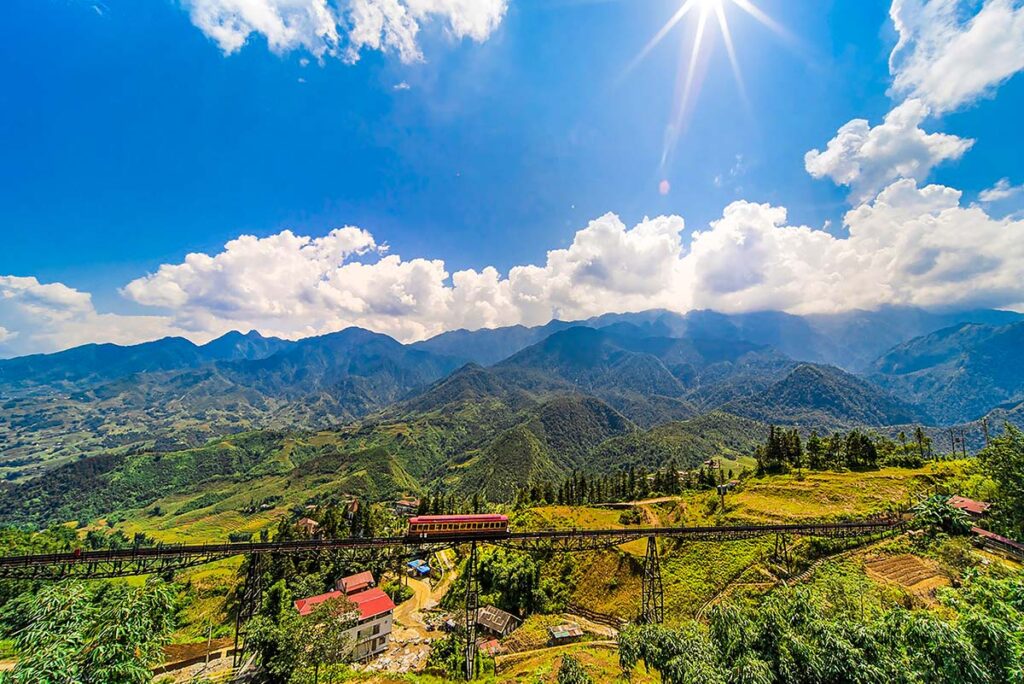
Das Abenteuer zum Fansipan beginnt mit dem Muong Hoa Mountain Train, einem Highlight für sich. Abfahrend von Sapa City, in der Nähe des MGallery Hotels, bietet dieser Standseilzug den Passagieren eine malerische Fahrt durch die berühmten Reisfelder des Muong Hoa Tals. Die Route umfasst die Durchfahrt durch mehrere Tunnel und das Überqueren eines atemberaubenden Viadukts, was atemberaubende Ausblicke bietet und die natürliche Schönheit, die dich erwartet, perfekt in Szene setzt.
2. Die Seilbahn
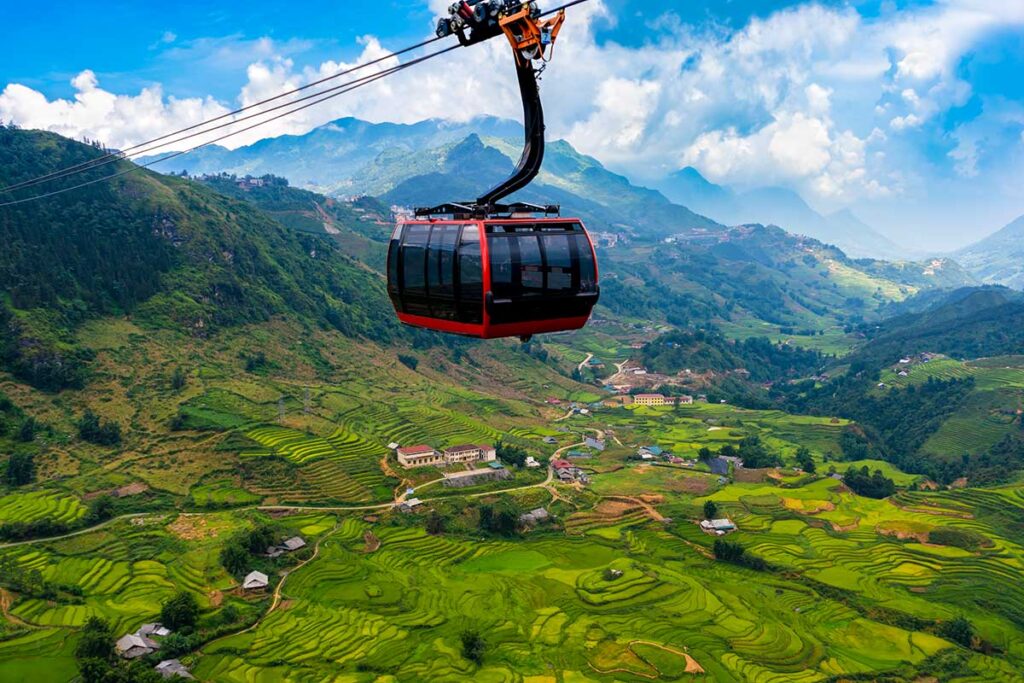
Sobald die Seilbahn den Dock verlässt, schwebt sie über eine malerische Landschaft aus Bauernhöfen und Reisterrassen, mit weitreichenden Ausblicken ins neblige Tal. Der Aufstieg der Seilbahn durch die Wolken ist ein dynamisches Schauspiel, bei dem die Sicht schnell von dichtem Nebel zu klaren, atemberaubenden Aussichten wechselt. Diese Fahrt ist nicht nur ein Mittel, um den Gipfel zu erreichen; der sich verändernde Nebel, die steilen Bergrücken und dichten Wälder machen die Reise selbst zu einem unvergesslichen Highlight. Der abschließende steile Aufstieg bietet beeindruckende Ausblicke, kann jedoch eine spannende Herausforderung für Höhenangst sein.
3. Die Aussichtsplattform
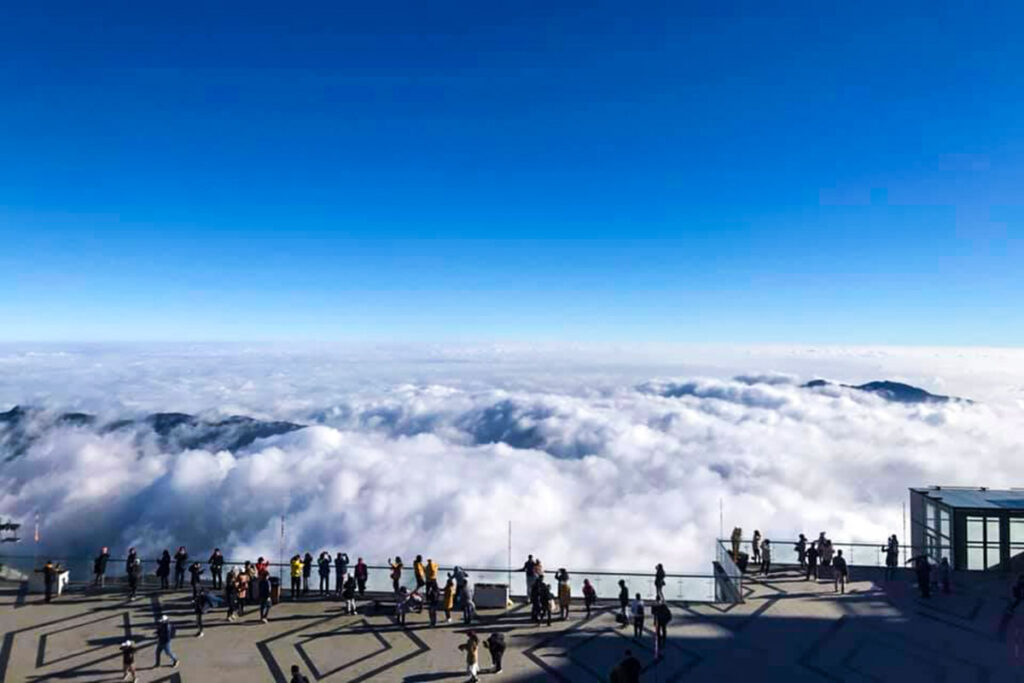
Nach dem Verlassen der Seilbahnstation betreten die Besucher eine große, flache Aussichtsplattform, die dramatisch auf den steilen Abhang des Berges blickt. Oft in Nebel gehüllt, bietet die Plattform eine fast mystische Atmosphäre, mit ständig wechselnden Ausblicken. An klaren Tagen bietet das Deck eine Mischung aus blauem Himmel und Wolken, die die Berglandschaft durchziehen. Dieser Ort dient auch als Ausgangspunkt für den Aufstieg zum Gipfel, der von einer großen Treppe markiert wird, die weitere Erkundungen und Schönheiten verspricht.
4. Die Standseilbahn zum Gipfel
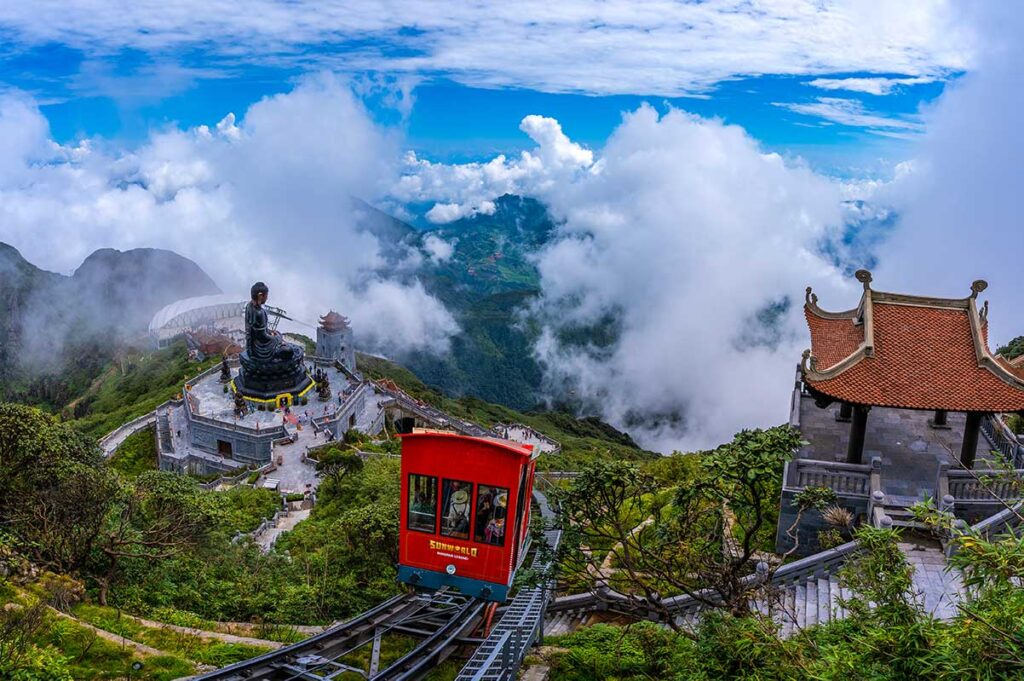
Die Do Quyen Mountain Train bietet eine alternative Möglichkeit, den Gipfel des Fansipan zu erreichen, besonders vorteilhaft für diejenigen, die den Aufstieg aufgrund von Gesundheitsproblemen oder Wetterbedingungen als herausfordernd empfinden. Praktisch neben der Seilbahnstation gelegen, bietet dieser Zug eine komfortable Fahrt mit malerischen Ausblicken auf die Berge, Tempel und Statuen, die Fansipan Sunworld ausmachen. Tickets sind sowohl für einfache als auch für Hin- und Rückfahrten erhältlich und bieten den Besuchern Flexibilität je nach Vorlieben und Bedingungen.
5. Der Fansipan-Gipfel
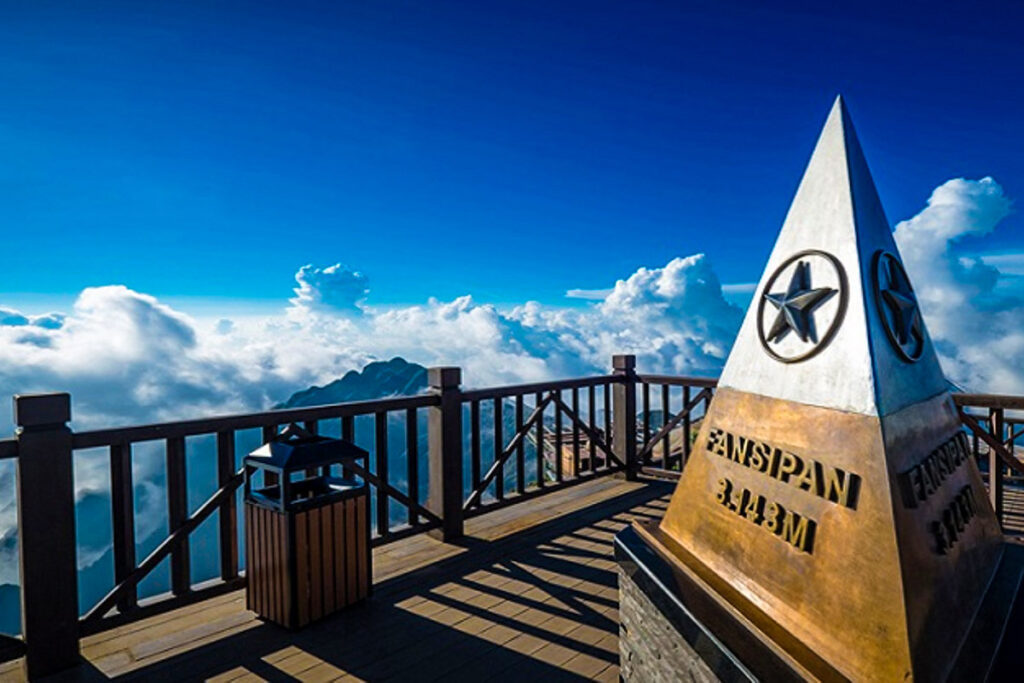
Die Reise von der Station zum Gipfel beinhaltet das Besteigen von 600 Stufen, aber die Belohnung ist der unglaubliche Panoramablick vom höchsten Punkt Vietnams. Dieses Gipfelerlebnis ist ein Muss und bietet ein Gefühl der Erfüllung sowie atemberaubende Ausblicke. Oben gibt es mehrere Plattformen, die in jede Richtung fantastische Ausblicke bieten.
6. Der Bich Van Thien Tu Tempel
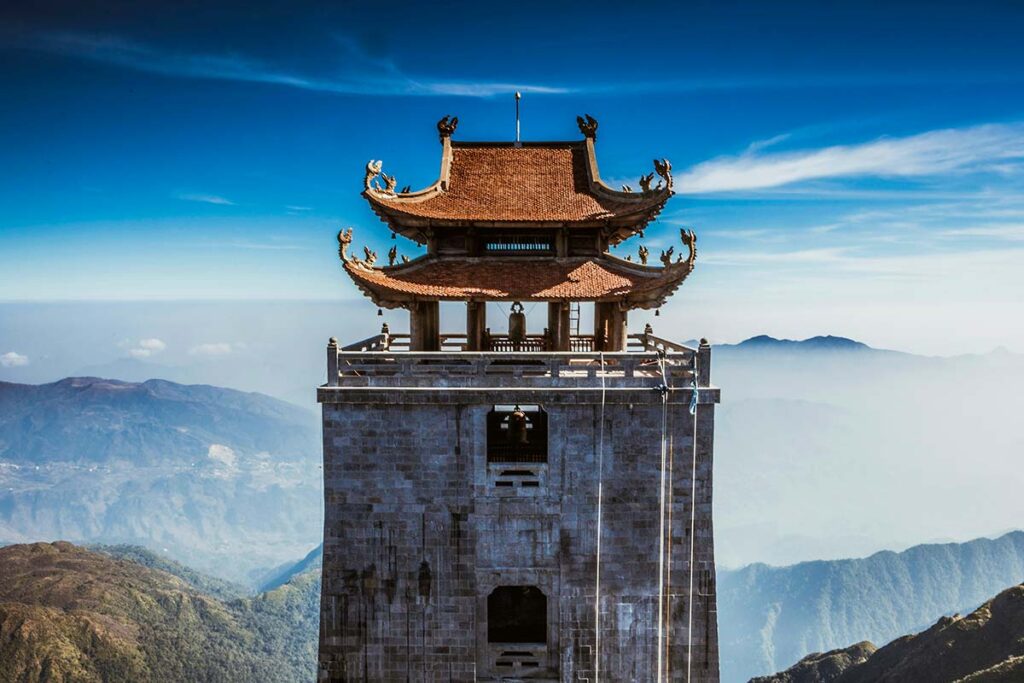
Auf einer Höhe von 3.037 Metern, mitten im blauen Himmel, liegt der Bich Van Thien Tu Tempel, die erste spirituelle Stätte, die Besucher auf dem Gipfel des Fansipan antreffen. Dieser Tempel, im architektonischen Stil der Tran-Dynastie erbaut, ist ein Zeugnis des reichen spirituellen Erbes Vietnams.
7. Die Pho Minh Pagode
Die Pho Minh Pagode auf dem Fansipan zieht ihre architektonische Inspiration von der berühmten Pho Minh Pagode in Nam Dinh, bekannt als der Ort, an dem die Reliquien des Buddha-Kaisers Tran Nhan Tong aufbewahrt werden.
8. Bodhisattva Statue
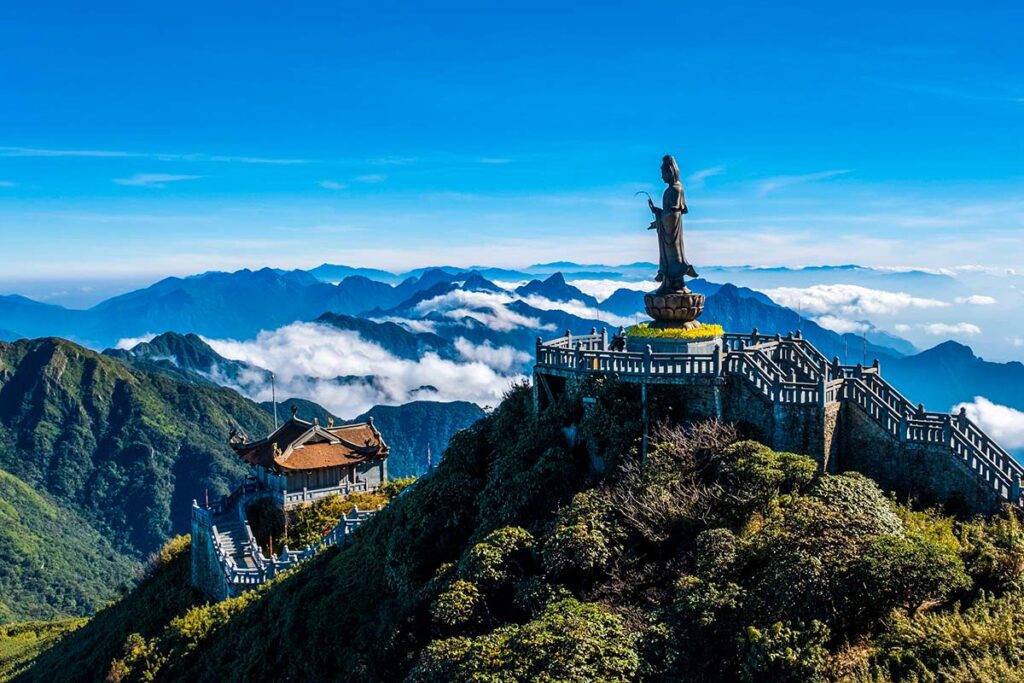
Auf einem Bergrücken thronend, ist die imposante Bodhisattva Statue ein majestätischer Anblick, der hoch aufragt und über die weite Bergkette blickt. Während die Fernansichten spektakulär sind, bietet die Aussichtsplattform direkt unterhalb der Statue einen hervorragenden Ort für ungestörte Fotografie, die sowohl die Statue als auch die Bergkulisse einfängt.
9. Der Statuen-Weg entlang des Berges
Dieser Weg bietet eine einzigartige Wahl für Besucher: Zurück über die gleiche Route, viele Treppen steigen, oder einen Weg entlang der Bergkante nehmen. Letztere Option ist gesäumt von einer faszinierenden Reihe von Mönchs-Statuen, jede mit einzigartigen und teils ungewöhnlichen Gesichtsausdrücken. Begleitet von Tafeln (auf Vietnamesisch), die ihre historische Bedeutung zusammenfassen, repräsentieren diese Statuen historische Persönlichkeiten der Tempel und keine Gottheiten.
Dieser Teil des Fansipan bietet eine ruhigere, kontemplative Erfahrung und ermöglicht es den Besuchern, über die Persönlichkeiten und Geschichten dieser historischen Figuren nachzudenken, während sie den malerischen Spaziergang genießen.
10. Die Amitabha-Buddha-Statue
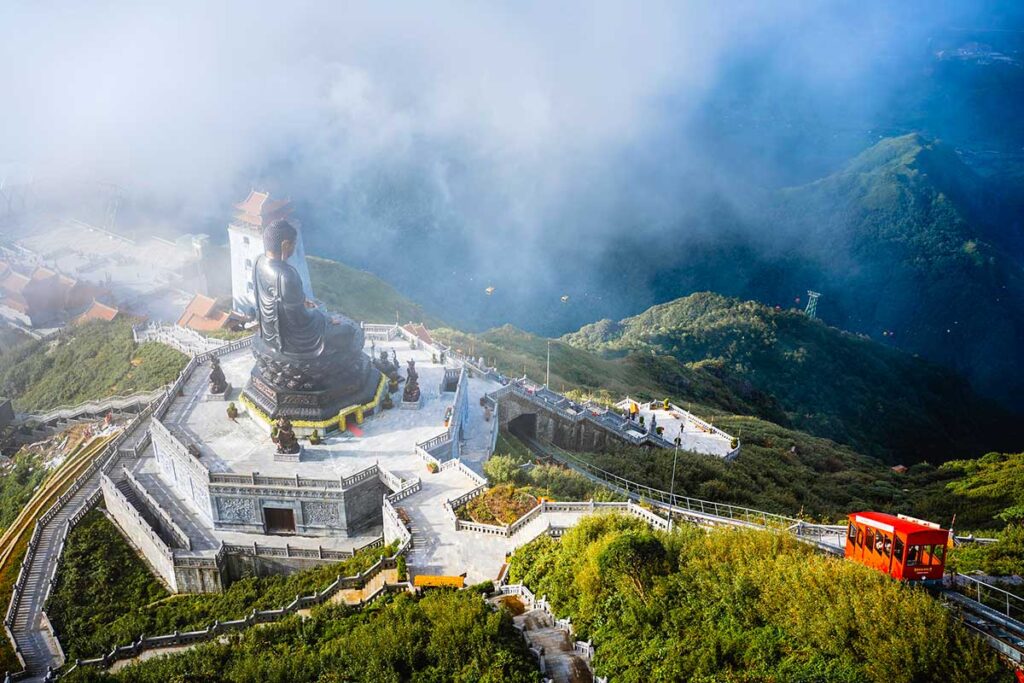
Die Amitabha-Buddha-Statue, eine jüngste Ergänzung zu Fansipan, wurde 2015 fertiggestellt und steht in majestätischen 21,5 Metern Höhe. Im Sockel befindet sich ein spezieller Raum, der einem Gebetsbereich ähnelt und den Ngoc Xa Loi Buddha beherbergt.
11. Der höchste Flaggenmast Indochinas
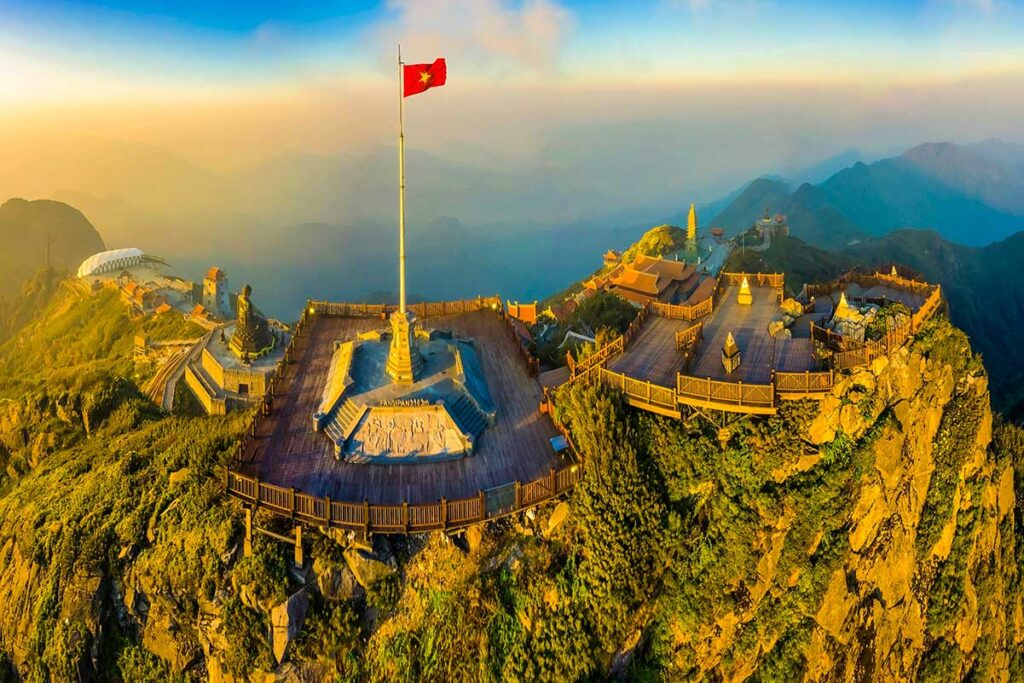
Der Flaggenmast auf dem Fansipan, obwohl nicht so bekannt wie der Lung Cu Flaggenmast in Ha Giang, hält laut SunWorld den Titel des höchsten Flaggenmasts in Indochina. Mit einer Höhe von 25 Metern ist der Sockel dieses Flaggenmasts mit detaillierten Reliefs verziert, die die Essenz der vietnamesischen Kultur verkörpern. Diese künstlerischen Darstellungen umfassen die Cham-Türme, Pfahlhäuser der Zentralen Hochländer, nordwestliche Kulturen und die ikonische Halong-Bucht, was ihn zu einem Symbol des nationalen Stolzes und der kulturellen Vielfalt macht.
12. Nützliche Einrichtungen
Obwohl vielleicht nicht die Hauptattraktion, tragen die verschiedenen Einrichtungen am Gipfel zur Bequemlichkeit und zum Komfort des Fansipan-Erlebnisses bei. Restaurants in der Nähe der oberen Seilbahnstation, obwohl etwas teurer als in der Stadt, bieten eine angenehme Umgebung, um eine Mahlzeit mit Aussicht zu genießen.
Zusätzlich bieten mehrere Cafés einen gemütlichen Ort für ein heißes Getränk, besonders an kälteren Tagen, oder eine entspannende Pause nach dem Erkunden der Tempel. Das Café du Soleil mit seinen bodentiefen Fenstern bietet einen außergewöhnlichen Blick auf die Umgebung. Für diejenigen, die ein Stück Fansipan mit nach Hause nehmen möchten, gibt es auch vier verschiedene Geschäfte, die Snacks und Souvenirs verkaufen.
Tipps für den Besuch
Fansipan besteigen oder in Sapa wandern?
Für Besucher mit begrenzter Zeit könnte das Wandern in Sapa eine bevorzugte Option gegenüber dem Besteigen des Fansipan sein. Wanderungen bieten einen umfassenderen Blick auf die berühmten terrassierten Reisfelder und ethnischen Minderheitendörfer der Region. Außerdem garantiert Wandern im Tal in der Regel, dass du etwas siehst und erlebst, unabhängig vom Wetter, während der Gipfel des Fansipan manchmal keine Sicht bietet.
Beste Zeit für einen Besuch des Mount Fansipan
- Ideale Monate: Die klarsten Aussichten gibt es normalerweise von März bis Mai.
- Regenzeit: Juni bis Oktober bietet eine gute Chance auf klaren Himmel, aber es ist auch die Regenzeit.
- Wintermonate: Von November bis Februar ist es kälter mit häufigem Wolkenbedeckung, die die Sicht behindern kann.
- Optimale Tageszeit: Nachmittage sind oft klarer, da die Morgenstunden niedrige Wolken haben können. Über den Wolken zu sein, kann eine epische Aussicht bieten, aber es ist ein Glücksspiel.
Tram Ton Pass und Wasserfälle
Der Tram Ton Pass, auf der anderen Seite des Fansipan gegenüber von Sapa gelegen, ist der höchste Gebirgspass Vietnams und bietet atemberaubende Ausblicke. Er ist mit dem Taxi oder gemieteten Motorrad erreichbar. In der Nähe befinden sich zwei bemerkenswerte Wasserfälle: der Silver Waterfall, direkt an der Straße, und der Love Waterfall, erreichbar über eine malerische halbstündige Wanderung. Der Pfad zum Besteigen des Fansipan beginnt auch in der Nähe des Love Waterfall.
Das Wetter überprüfen
Bevor du deine Reise zum Fansipan planst, ist es wichtig, den Wetterbericht zu überprüfen. Die Auswahl des richtigen Tages und der richtigen Uhrzeit kann die Chance erheblich erhöhen, die besten Ausblicke zu erleben.
Schnee
Einzigartig für Sapa ist die Möglichkeit von Schneefall, hauptsächlich im Dezember und Januar. Dieses seltene Ereignis in Vietnam zieht viele Einheimische an, die noch nie zuvor Schnee gesehen haben.
Warme Kleidung
Unabhängig von der Wettervorhersage ist es ratsam, warme Kleidung mitzubringen, wenn du den Fansipan besuchst. Der Gipfel kann ziemlich kalt sein, besonders wenn er in Wolken gehüllt ist, daher wird eine gute Vorbereitung dein Erlebnis angenehmer machen.
